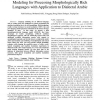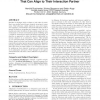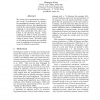101
click to vote
EMNLP
2009
14 years 10 months ago
2009
Unknown lexical items present a major obstacle to the development of broadcoverage semantic role labeling systems. We address this problem with a semisupervised learning approach ...
114
click to vote
TASLP
2008
15 years 15 days ago
2008
Language modeling for an inflected language such as Arabic poses new challenges for speech recognition and machine translation due to its rich morphology. Rich morphology results i...
111
click to vote
ATAL
2010
Springer
15 years 1 months ago
2010
Springer
Speakers in dialogue tend to adapt to each other by starting to use similar lexical items, syntactic structures, or gestures. This behaviour, called alignment, may serve important...
100
Voted
NAACL
1994
15 years 1 months ago
1994
This paper describes a semi-automatic method for associating a Japanese lexicon with a semantic concept taxonomy called an ontology, using a Japanese-English bilingual dictionary ...
93
Voted
ACL
1994
15 years 1 months ago
1994
The computational lexicalization of a grammar is the optimization of the links between lexicalized rules and lexical items in order to improve the quality of the bottom-up filteri...
112
click to vote
ACL
1997
15 years 1 months ago
1997
We present and experimentally evaluate a new model of pronunciation by analogy: the paradigmatic cascades model. Given a pronunciation lexicon, this algorithm first extracts the m...
108
click to vote
LACL
2005
Springer
15 years 6 months ago
2005
Springer
The Minimalist Grammars (MGs) proposed by Stabler(1997) have tree-shaped derivations (Harkema, 2001b; Michaelis, 2001a). As in categorial grammars, each lexical item is an associat...
132
Voted
ICNC
2005
Springer
15 years 6 months ago
2005
Springer
Abstract. The method of lexical chains is the first time introduced to generate summaries from Chinese texts. The algorithm which computes lexical chains based on the HowNet knowl...



